Advancements in Triboelectric Nanogenerators (TENGs) for Intelligent Transportation Infrastructure: Enhancing Bridges, Highways, and Tunnels
Abstract
:1. Introduction
2. Fundamental Physics Modes of Triboelectric Nanogenerators
3. Overview of Self-Powered Sensors for Intelligent Road Environments
3.1. Self-Powered Sensor Based on the Triboelectric Nanogenerators for Bridges
3.2. Self-Powered Sensor Based on the Triboelectric Nanogenerators for Tunnels
3.3. Self-Powered Sensor Based on the Triboelectric Nanogenerators for Highways
3.4. Smart Infrastructure for Harvesting Energy from Roads
3.5. Self-Powered Vehicle Sensors Based on Triboelectric Nanogenerators for Road Intelligent Systems
3.6. Smart Pedestrian Crossing System Based on the Triboelectric Nanogenerators
3.7. Self-Powered Sensors Based on Triboelectric Nanogenerators for Monitoring Driving Behaviors
4. Materials for Triboelectric Nanogenerator-Based Self-Powered Sensors in Transportation Infrastructure including Bridges, Highways, and Tunnels
- Self-powered sensor based on triboelectric nanogenerators for bridges: Polymeric materials: polydimethylsiloxane (PDMS), polytetrafluoroethylene (PTFE), polyvinylidene fluoride (PVDF), and their composites. Conductive materials: indium tin oxide (ITO), graphene, carbon nanotubes (CNTs), and silver nanowires. Substrate materials: flexible and durable materials such as polyimide, polyethylene terephthalate (PET), or polyethylene naphthalate (PEN). Encapsulation materials: to protect the TENG-based sensor from environmental factors, materials like epoxy resins or silicone elastomers are commonly used.
- Self-powered sensor based on triboelectric nanogenerators for tunnels: Similar to bridge applications, polymeric materials (PDMS, PTFE, PVDF) and conductive materials (ITO, graphene, CNTs) are frequently used. Special attention is given to materials with high durability and resistance to moisture, dust, and harsh underground conditions.
- Self-powered sensor based on triboelectric nanogenerators for highways: Materials used in highway applications are typically selected for their robustness, flexibility, and resistance to weathering. Flexible polymers, such as PDMS, PTFE, and PVDF, are commonly employed due to their resilience and ability to withstand external forces. Conductive materials, including ITO, graphene, CNTs, and silver nanowires, are used to ensure efficient charge transfer and conductivity.
- Smart infrastructure to harvest energy from roads: Materials used for energy harvesting systems integrated into roads should possess high piezoelectric or triboelectric properties. Piezoelectric materials: lead zirconate titanate (PZT), zinc oxide (ZnO), polyvinylidene fluoride (PVDF), and its copolymers. Triboelectric materials: PDMS, PTFE, PVDF, and their composites, as well as materials with high triboelectric coefficients, like polyamide or polyethylene.
- Self-powered vehicle sensors based on triboelectric nanogenerators for road intelligent systems: Similar to bridge and highway applications, flexible polymers (PDMS, PTFE, PVDF) and conductive materials (ITO, graphene, CNTs) are commonly used. Additionally, pressure-sensitive materials, such as pressure-sensitive films or elastomers, are employed to capture vehicle-related parameters.
- Smart pedestrian crossing system based on triboelectric nanogenerators: Materials used in smart pedestrian crossing systems require good triboelectric properties and mechanical resilience. PDMS, PTFE, PVDF, and their composites are commonly used for the triboelectric layers. For the structural components, flexible and durable materials like PET, PEN, or elastomers are employed.
5. Challenges, Perspective, and Insight for Self-Powered Sensors for Intelligent Road Environments
- Materials: Researchers should continue to investigate advanced materials with enhanced triboelectric properties and mechanical resilience. This includes exploring new polymeric materials, such as polymethylpentene (PMP), thermoplastic polyurethane (TPU), or composites with improved performance. Additionally, the exploration of novel conductive materials like carbon-based nanomaterials, metal oxides, or conducting polymers can contribute to higher charge transfer efficiency.
- Designs: The design of TENGs for intelligent transportation infrastructure should focus on maximizing energy conversion efficiency and system integration. Novel design approaches, such as multilayered structures, hierarchical structures, or patterned surface modifications, can enhance the overall performance of TENGs. Exploring innovative electrode designs, such as microstructured surfaces or three-dimensional architectures, can also improve energy harvesting capabilities.
- Structures: Researchers should explore adaptable and scalable TENG structures to accommodate various transportation infrastructure applications. Developing flexible and conformable TENGs that can be easily integrated into different surfaces, such as bridges, highways, and tunnels, is crucial. Additionally, investigating self-powered sensing systems with distributed TENGs to enable large-scale monitoring and data collection would be beneficial.
6. Conclusions
Author Contributions
Funding
Institutional Review Board Statement
Informed Consent Statement
Data Availability Statement
Conflicts of Interest
References
- Matin Nazar, A.; Idala Egbe, K.-J.; Abdollahi, A.; Hariri-Ardebili, M.A. Triboelectric nanogenerators for energy harvesting in ocean: A review on application and hybridization. Energies 2021, 14, 5600. [Google Scholar] [CrossRef]
- Nazar, A.M.; Jiao, P.; Zhang, Q.; Egbe, K.-J.I.; Alavi, A.H. A new structural health monitoring approach based on smartphone measurements of magnetic field intensity. IEEE Instrum. Meas. Mag. 2021, 24, 49–58. [Google Scholar] [CrossRef]
- Matin Nazar, A.; Egbe, K.-J.I.; Jiao, P. Hybrid Piezoelectric and Triboelectric Nanogenerators for Energy Harvesting and Walking Sensing. Energy Technol. 2022, 10, 2200063. [Google Scholar] [CrossRef]
- Egbe, K.-J.I.; Nazar, A.M.; Jiao, P.; Yang, Y.; Ye, X.; Wang, H. Vibrational turbine piezoelectric nanogenerators for energy harvesting in multiphase flow fields. Energy Rep. 2021, 7, 6384–6393. [Google Scholar] [CrossRef]
- Varmaghani, A.; Matin Nazar, A.; Ahmadi, M.; Sharifi, A.; Jafarzadeh Ghoushchi, S.; Pourasad, Y. DMTC: Optimize energy consumption in dynamic wireless sensor network based on fog computing and fuzzy multiple attribute decision-making. Wirel. Commun. Mob. Comput. 2021, 2021, 1–14. [Google Scholar] [CrossRef]
- Wang, Y.; Matin Nazar, A.; Wang, J.; Xia, K.; Wang, D.; Ji, X.; Jiao, P. Rolling Spherical Triboelectric Nanogenerators (RS-TENG) under Low-Frequency Ocean Wave Action. J. Mar. Sci. Eng. 2021, 10, 5. [Google Scholar] [CrossRef]
- Ayegba, B.O.; Egbe, K.-J.I.; Matin Nazar, A.; Huang, M.; Hariri-Ardebili, M.A. Resource Efficiency and Thermal Comfort of 3D Printable Concrete Building Envelopes Optimized by Performance Enhancing Insulation: A Numerical Study. Energies 2022, 15, 1069. [Google Scholar] [CrossRef]
- Liu, H.; Egbe, K.-J.I.; Wang, H.; Matin Nazar, A.; Jiao, P.; Zhu, R. A numerical study on 3D printed cementitious composites mixes subjected to axial compression. Materials 2021, 14, 6882. [Google Scholar] [CrossRef]
- Alavi, A.H.; Hasni, H.; Lajnef, N.; Chatti, K.; Faridazar, F. An intelligent structural damage detection approach based on self-powered wireless sensor data. Autom. Constr. 2016, 62, 24–44. [Google Scholar] [CrossRef]
- Egbe, K.-J.I.; Nazar, A.M.; Jiao, P. Piezoelectric-Triboelectric-Electromagnetic Hybrid Rotational Energy Harvesters (H-REH). Int. J. Mech. Sci. 2022, 235, 107722. [Google Scholar] [CrossRef]
- Gandomi, A.H.; Alavi, A.H.; Asghari, A.; Niroomand, H.; Nazar, A.M. An innovative approach for modeling of hysteretic energy demand in steel moment resisting frames. Neural Comput. Appl. 2014, 24, 1285–1291. [Google Scholar] [CrossRef]
- Nazar, A.M.; Egbe, K.-J.I.; Jiao, P.; Alavi, A.H. A novel multi-mode magnetic triboelectric nanogenerator energy harvesting system. In Behavior and Mechanics of Multifunctional Materials XV; SPIE: New York, NY, USA, 2021; pp. 49–56. [Google Scholar]
- Egbe, K.-J.I.; Nazar, A.M.; Jiao, P.; Alavi, A.H. Harnessing postbuckling instability of piezoelectric cylinders with corrugation for energy harvesting. In Active and Passive Smart Structures and Integrated Systems XV; SPIE: New York, NY, USA, 2021; pp. 277–284. [Google Scholar]
- Sadeghi, F.; Zhu, X.; Li, J.; Rashidi, M. A novel slip sensory system for interfacial condition monitoring of steel-concrete composite bridges. Remote Sens. 2021, 13, 3377. [Google Scholar] [CrossRef]
- Rayegani, A.; Nouri, G. Application of Smart Dampers for Prevention of Seismic Pounding in Isolated Structures Subjected to Near-fault Earthquakes. J. Earthq. Eng. 2020, 26, 4069–4084. [Google Scholar] [CrossRef]
- Rayegani, A.; Nouri, G. Seismic collapse probability and life cycle cost assessment of isolated structures subjected to pounding with smart hybrid isolation system using a modified fuzzy based controller. Structures 2022, 44, 30–41. [Google Scholar] [CrossRef]
- Papadimitratos, P.; De La Fortelle, A.; Evenssen, K.; Brignolo, R.; Cosenza, S. Vehicular communication systems: Enabling technologies, applications, and future outlook on intelligent transportation. IEEE Commun. Mag. 2009, 47, 84–95. [Google Scholar] [CrossRef] [Green Version]
- Pengcheng, J.; Nazar, A.M.; Yang, Y. Ocean Wave Energy Collector Based on Magnetic Force and Triboelectric Effect. US Patent Application 17/611,906, 29 September 2022. [Google Scholar]
- Mingwei, L.; Lin, L. Intelligent transportation system in China: The optimal evaluation period of transportation’s application performance. J. Intell. Fuzzy Syst. 2020, 38, 6979–6990. [Google Scholar] [CrossRef]
- Jiao, P.; Matin Nazar, A.; Egbe, K.-J.I.; Rayegani, A. Magnetically circular layers triboelectric nanogenerators (MCL-TENG) for velocity sensing and damage detection. Sustain. Energy Technol. Assess. 2022, 53, 102644. [Google Scholar] [CrossRef]
- Rahimi Sardo, F.; Rayegani, A.; Matin Nazar, A.; Balaghiinaloo, M.; Saberian, M.; Mohsan, S.A.H.; Alsharif, M.H.; Cho, H.-S. Recent Progress of Triboelectric Nanogenerators for Biomedical Sensors: From Design to Application. Biosensors 2022, 12, 697. [Google Scholar] [CrossRef]
- Fan, F.-R.; Tian, Z.-Q.; Wang, Z.L. Flexible triboelectric generator. Nano Energy 2012, 1, 328–334. [Google Scholar] [CrossRef]
- Seung, W.; Yoon, H.J.; Kim, T.Y.; Kang, M.; Kim, J.; Kim, H.; Kim, S.M.; Kim, S.W. Dual friction mode textile-based tire cord triboelectric nanogenerator. Adv. Funct. Mater. 2020, 30, 2002401. [Google Scholar] [CrossRef]
- Yang, Y.; Zhu, G.; Zhang, H.; Chen, J.; Zhong, X.; Lin, Z.-H.; Su, Y.; Bai, P.; Wen, X.; Wang, Z.L. Triboelectric nanogenerator for harvesting wind energy and as self-powered wind vector sensor system. ACS Nano 2013, 7, 9461–9468. [Google Scholar] [CrossRef]
- Guldentops, G.; Nejad, A.M.; Vuye, C.; Rahbar, N. Performance of a pavement solar energy collector: Model development and validation. Appl. Energy 2016, 163, 180–189. [Google Scholar] [CrossRef]
- Zhu, J.; Zhu, M.; Shi, Q.; Wen, F.; Liu, L.; Dong, B.; Haroun, A.; Yang, Y.; Vachon, P.; Guo, X. Progress in TENG technology—A journey from energy harvesting to nanoenergy and nanosystem. EcoMat 2020, 2, e12058. [Google Scholar] [CrossRef]
- Chen, L.; Shi, Q.; Sun, Y.; Nguyen, T.; Lee, C.; Soh, S. Controlling surface charge generated by contact electrification: Strategies and applications. Adv. Mater. 2018, 30, 1802405. [Google Scholar] [CrossRef] [PubMed]
- Zhang, Z.; Bai, Y.; Xu, L.; Zhao, M.; Shi, M.; Wang, Z.L.; Lu, X. Triboelectric nanogenerators with simultaneous outputs in both single-electrode mode and freestanding-triboelectric-layer mode. Nano Energy 2019, 66, 104169. [Google Scholar] [CrossRef]
- Shi, Q.; Lee, C. Self-powered bio-inspired spider-net-coding interface using single-electrode triboelectric nanogenerator. Adv. Sci. 2019, 6, 1900617. [Google Scholar] [CrossRef] [Green Version]
- Yang, Y.; Zhang, H.; Chen, J.; Jing, Q.; Zhou, Y.S.; Wen, X.; Wang, Z.L. Single-electrode-based sliding triboelectric nanogenerator for self-powered displacement vector sensor system. Acs Nano 2013, 7, 7342–7351. [Google Scholar] [CrossRef]
- Niu, S.; Liu, Y.; Wang, S.; Lin, L.; Zhou, Y.S.; Hu, Y.; Wang, Z.L. Theoretical investigation and structural optimization of single-electrode triboelectric nanogenerators. Adv. Funct. Mater. 2014, 24, 3332–3340. [Google Scholar] [CrossRef]
- Roshani, H.; Dessouky, S.; Montoya, A.; Papagiannakis, A. Energy harvesting from asphalt pavement roadways vehicle-induced stresses: A feasibility study. Appl. Energy 2016, 182, 210–218. [Google Scholar] [CrossRef]
- Niu, S.; Wang, Z.L. Theoretical systems of triboelectric nanogenerators. Nano Energy 2015, 14, 161–192. [Google Scholar] [CrossRef] [Green Version]
- Wang, Z.L. On Maxwell’s displacement current for energy and sensors: The origin of nanogenerators. Mater. Today 2017, 20, 74–82. [Google Scholar] [CrossRef]
- Askari, H.; Khajepour, A.; Khamesee, M.B.; Saadatnia, Z.; Wang, Z.L. Piezoelectric and triboelectric nanogenerators: Trends and impacts. Nano Today 2018, 22, 10–13. [Google Scholar] [CrossRef]
- Dong, K.; Peng, X.; Wang, Z.L. Fiber/fabric-based piezoelectric and triboelectric nanogenerators for flexible/stretchable and wearable electronics and artificial intelligence. Adv. Mater. 2020, 32, 1902549. [Google Scholar] [CrossRef] [PubMed]
- Matin Nazar, A.; Narazaki, Y.; Rayegani, A.; Rahimi Sardo, F. Recent progress of triboelectric nanogenerators as self-powered sensors in transportation engineering. Measurement 2022, 203, 112010. [Google Scholar] [CrossRef]
- Rayegani, A.; Saberian, M.; Delshad, Z.; Liang, J.; Sadiq, M.; Nazar, A.M.; Mohsan, S.A.H.; Khan, M.A. Recent Advances in Self-Powered Wearable Sensors Based on Piezoelectric and Triboelectric Nanogenerators. Biosensors 2022, 13, 37. [Google Scholar] [CrossRef] [PubMed]
- Liu, Y.; Habibnezhad, M.; Jebelli, H. Worker-Aware Task Planning for Construction Robots: A Physiologically Based Communication Channel Interface. In Automation and Robotics in the Architecture, Engineering, and Construction Industry; Springer: Berlin/Heidelberg, Germany, 2022; pp. 181–200. [Google Scholar]
- Yao, H.; Wang, Z.; Wu, Y.; Zhang, Y.; Miao, K.; Cui, M.; Ao, T.; Zhang, J.; Ban, D.; Zheng, H. Intelligent sound monitoring and identification system combining triboelectric nanogenerator-based self-powered sensor with deep learning technique. Adv. Funct. Mater. 2022, 32, 2112155. [Google Scholar] [CrossRef]
- Pang, Y.; Zhu, X.; Yu, Y.; Liu, S.; Chen, Y.; Feng, Y. Waterbomb-origami inspired triboelectric nanogenerator for smart pavement-integrated traffic monitoring. Nano Res. 2022, 15, 5450–5460. [Google Scholar] [CrossRef]
- Pang, Y.; Zhu, X.; Lee, C.; Liu, S. Triboelectric nanogenerator as next-generation self-powered sensor for cooperative vehicle-infrastructure system. Nano Energy 2022, 97, 107219. [Google Scholar] [CrossRef]
- Pandey, P.; Jung, D.-H.; Choi, G.-J.; Seo, M.-K.; Lee, S.; Kim, J.M.; Park, I.-K.; Sohn, J.I. Nafion-mediated barium titanate-polymer composite nanofibers-based triboelectric nanogenerator for self-powered smart street and home control system. Nano Energy 2023, 107, 108134. [Google Scholar] [CrossRef]
- Cao, J.; Lin, Y.; Fu, X.; Wang, Z.; Liu, G.; Zhang, Z.; Qin, Y.; Zhou, H.; Dong, S.; Cheng, G. Self-powered overspeed wake-up alarm system based on triboelectric nanogenerators for intelligent transportation. Nano Energy 2023, 107, 108150. [Google Scholar] [CrossRef]
- Jiang, D.; Lian, M.; Xu, M.; Sun, Q.; Xu, B.B.; Thabet, H.K.; El-Bahy, S.M.; Ibrahim, M.M.; Huang, M.; Guo, Z. Advances in triboelectric nanogenerator technology—Applications in self-powered sensors, Internet of things, biomedicine, and blue energy. Adv. Compos. Hybrid Mater. 2023, 6, 57. [Google Scholar] [CrossRef]
- Dong, K.; Wu, Z.; Deng, J.; Wang, A.C.; Zou, H.; Chen, C.; Hu, D.; Gu, B.; Sun, B.; Wang, Z.L. A stretchable yarn embedded triboelectric nanogenerator as electronic skin for biomechanical energy harvesting and multifunctional pressure sensing. Adv. Mater. 2018, 30, 1804944. [Google Scholar] [CrossRef] [PubMed]
- Wang, X.; Song, W.-Z.; You, M.-H.; Zhang, J.; Yu, M.; Fan, Z.; Ramakrishna, S.; Long, Y.-Z. Bionic single-electrode electronic skin unit based on piezoelectric nanogenerator. Acs Nano 2018, 12, 8588–8596. [Google Scholar] [CrossRef] [PubMed]
- Pu, X.; Guo, H.; Chen, J.; Wang, X.; Xi, Y.; Hu, C.; Wang, Z.L. Eye motion triggered self-powered mechnosensational communication system using triboelectric nanogenerator. Sci. Adv. 2017, 3, e1700694. [Google Scholar] [CrossRef] [PubMed] [Green Version]
- Zheng, H.; Zi, Y.; He, X.; Guo, H.; Lai, Y.-C.; Wang, J.; Zhang, S.L.; Wu, C.; Cheng, G.; Wang, Z.L. Concurrent harvesting of ambient energy by hybrid nanogenerators for wearable self-powered systems and active remote sensing. ACS Appl. Mater. Interfaces 2018, 10, 14708–14715. [Google Scholar] [CrossRef]
- Wang, X.; Wang, Z.L.; Yang, Y. Hybridized nanogenerator for simultaneously scavenging mechanical and thermal energies by electromagnetic-triboelectric-thermoelectric effects. Nano Energy 2016, 26, 164–171. [Google Scholar] [CrossRef]
- Chen, Y.; Wang, Y.C.; Zhang, Y.; Zou, H.; Lin, Z.; Zhang, G.; Zou, C.; Wang, Z.L. Elastic-beam triboelectric nanogenerator for high-performance multifunctional applications: Sensitive scale, acceleration/force/vibration sensor, and intelligent keyboard. Adv. Energy Mater. 2018, 8, 1802159. [Google Scholar] [CrossRef]
- Zi, Y.; Lin, L.; Wang, J.; Wang, S.; Chen, J.; Fan, X.; Yang, P.K.; Yi, F.; Wang, Z.L. Triboelectric–pyroelectric–piezoelectric hybrid cell for high-efficiency energy-harvesting and self-powered sensing. Adv. Mater. 2015, 27, 2340–2347. [Google Scholar] [CrossRef]
- Jin, L.; Deng, W.; Su, Y.; Xu, Z.; Meng, H.; Wang, B.; Zhang, H.; Zhang, B.; Zhang, L.; Xiao, X. Self-powered wireless smart sensor based on maglev porous nanogenerator for train monitoring system. Nano Energy 2017, 38, 185–192. [Google Scholar] [CrossRef]
- Maruccio, C.; Quaranta, G.; De Lorenzis, L.; Monti, G. Energy harvesting from electrospun piezoelectric nanofibers for structural health monitoring of a cable-stayed bridge. Smart Mater. Struct. 2016, 25, 085040. [Google Scholar] [CrossRef]
- Zhu, J.; Cho, M.; Li, Y.; He, T.; Ahn, J.; Park, J.; Ren, T.-L.; Lee, C.; Park, I. Machine learning-enabled textile-based graphene gas sensing with energy harvesting-assisted IoT application. Nano Energy 2021, 86, 106035. [Google Scholar] [CrossRef]
- Wen, F.; He, T.; Liu, H.; Chen, H.-Y.; Zhang, T.; Lee, C. Advances in chemical sensing technology for enabling the next-generation self-sustainable integrated wearable system in the IoT era. Nano Energy 2020, 78, 105155. [Google Scholar] [CrossRef]
- Sun, Z.; Zhu, M.; Zhang, Z.; Chen, Z.; Shi, Q.; Shan, X.; Yeow, R.C.H.; Lee, C. Artificial Intelligence of Things (AIoT) enabled virtual shop applications using self-powered sensor enhanced soft robotic manipulator. Adv. Sci. 2021, 8, 2100230. [Google Scholar] [CrossRef] [PubMed]
- Liu, L.; Guo, X.; Lee, C. Promoting smart cities into the 5G era with multi-field Internet of Things (IoT) applications powered with advanced mechanical energy harvesters. Nano Energy 2021, 88, 106304. [Google Scholar] [CrossRef]
- Shi, Q.; Zhang, Z.; He, T.; Sun, Z.; Wang, B.; Feng, Y.; Shan, X.; Salam, B.; Lee, C. Deep learning enabled smart mats as a scalable floor monitoring system. Nat. Commun. 2020, 11, 4609. [Google Scholar] [CrossRef]
- Yang, Y.; Jung, J.H.; Yun, B.K.; Zhang, F.; Pradel, K.C.; Guo, W.; Wang, Z.L. Flexible pyroelectric nanogenerators using a composite structure of lead-free KNbO3 nanowires. Adv. Mater. 2012, 24, 5357–5362. [Google Scholar] [CrossRef]
- Wang, J.; Zhang, H.; Xie, Y.; Yan, Z.; Yuan, Y.; Huang, L.; Cui, X.; Gao, M.; Su, Y.; Yang, W. Smart network node based on hybrid nanogenerator for self-powered multifunctional sensing. Nano Energy 2017, 33, 418–426. [Google Scholar] [CrossRef]
- Heo, D.; Chung, J.; Kim, B.; Yong, H.; Shin, G.; Cho, J.-W.; Kim, D.; Lee, S. Triboelectric speed bump as a self-powered automobile warning and velocity sensor. Nano Energy 2020, 72, 104719. [Google Scholar] [CrossRef]
- Wang, J.; He, T.; Lee, C. Development of neural interfaces and energy harvesters towards self-powered implantable systems for healthcare monitoring and rehabilitation purposes. Nano Energy 2019, 65, 104039. [Google Scholar] [CrossRef]
- Song, S.; Hou, Y.; Guo, M.; Wang, L.; Tong, X.; Wu, J. An investigation on the aggregate-shape embedded piezoelectric sensor for civil infrastructure health monitoring. Constr. Build. Mater. 2017, 131, 57–65. [Google Scholar] [CrossRef]
- Wang, Z.L.; Jiang, T.; Xu, L. Toward the blue energy dream by triboelectric nanogenerator networks. Nano Energy 2017, 39, 9–23. [Google Scholar] [CrossRef]
- Chen, J.; Wang, Z.L. Reviving vibration energy harvesting and self-powered sensing by a triboelectric nanogenerator. Joule 2017, 1, 480–521. [Google Scholar] [CrossRef]
- Wang, Z.L.; Song, J. Piezoelectric nanogenerators based on zinc oxide nanowire arrays. Science 2006, 312, 242–246. [Google Scholar] [CrossRef] [PubMed]
- Wang, Z.L. Triboelectric nanogenerator (TENG)—Sparking an energy and sensor revolution. Adv. Energy Mater. 2020, 10, 2000137. [Google Scholar] [CrossRef] [Green Version]
- Fabish, T.J.; Duke, C.B. Molecular charge states and contact charge exchange in polymers. J. Appl. Phys. 1977, 48, 4256–4266. [Google Scholar] [CrossRef]
- Liu, D.; Zhou, L.; Wang, Z.L.; Wang, J. Triboelectric nanogenerator: From alternating current to direct current. Iscience 2021, 24, 102018. [Google Scholar] [CrossRef]
- Li, X.; Xu, G.; Xia, X.; Fu, J.; Huang, L.; Zi, Y. Standardization of triboelectric nanogenerators: Progress and perspectives. Nano Energy 2019, 56, 40–55. [Google Scholar] [CrossRef]
- Wang, Z.L. From contact electrification to triboelectric nanogenerators. Rep. Prog. Phys. 2021, 84, 096502. [Google Scholar] [CrossRef]
- Wang, C.; Zhao, J.; Ma, C.; Sun, J.; Tian, L.; Li, X.; Li, F.; Han, X.; Liu, C.; Shen, C. Detection of non-joint areas tiny strain and anti-interference voice recognition by micro-cracked metal thin film. Nano Energy 2017, 34, 578–585. [Google Scholar] [CrossRef]
- Ke, K.H.; Chung, C.K. High-performance Al/PDMS TENG with novel complex morphology of two-height microneedles array for high-sensitivity force-sensor and self-powered application. Small 2020, 16, 2001209. [Google Scholar] [CrossRef]
- LináWang, Z. Triboelectric nanogenerators as new energy technology and self-powered sensors–Principles, problems and perspectives. Faraday Discuss. 2014, 176, 447–458. [Google Scholar]
- Zhu, G.; Peng, B.; Chen, J.; Jing, Q.; Wang, Z.L. Triboelectric nanogenerators as a new energy technology: From fundamentals, devices, to applications. Nano Energy 2015, 14, 126–138. [Google Scholar] [CrossRef] [Green Version]
- Wu, C.; Wang, A.C.; Ding, W.; Guo, H.; Wang, Z.L. Triboelectric nanogenerator: A foundation of the energy for the new era. Adv. Energy Mater. 2019, 9, 1802906. [Google Scholar] [CrossRef]
- Zhao, D.; Yu, X.; Wang, Z.; Wang, J.; Li, X.; Wang, Z.L.; Cheng, T. Universal equivalent circuit model and verification of current source for triboelectric nanogenerator. Nano Energy 2021, 89, 106335. [Google Scholar] [CrossRef]
- Luo, J.; Wang, Z.L. Recent progress of triboelectric nanogenerators: From fundamental theory to practical applications. EcoMat 2020, 2, 12059. [Google Scholar] [CrossRef]
- Jung, Y.S.; Jeong, D.H.; Kang, S.B.; Kim, F.; Jeong, M.H.; Lee, K.-S.; Son, J.S.; Baik, J.M.; Kim, J.-S.; Choi, K.J. Wearable solar thermoelectric generator driven by unprecedentedly high temperature difference. Nano Energy 2017, 40, 663–672. [Google Scholar] [CrossRef]
- Siddique, A.R.M.; Mahmud, S.; Van Heyst, B. A review of the state of the science on wearable thermoelectric power generators (TEGs) and their existing challenges. Renew. Sustain. Energy Rev. 2017, 73, 730–744. [Google Scholar] [CrossRef]
- Yu, K.; Rich, S.; Lee, S.; Fukuda, K.; Yokota, T.; Someya, T. Organic photovoltaics: Toward self-powered wearable electronics. Proc. IEEE 2019, 107, 2137–2154. [Google Scholar] [CrossRef]
- Singh, G.K. Solar power generation by PV (photovoltaic) technology: A review. Energy 2013, 53, 1–13. [Google Scholar] [CrossRef]
- Hirose, T.; Matsuo, H. Standalone hybrid wind-solar power generation system applying dump power control without dump load. IEEE Trans. Ind. Electron. 2011, 59, 988–997. [Google Scholar] [CrossRef]
- Tayebi, L.; Zamanipour, Z.; Vashaee, D. Design optimization of micro-fabricated thermoelectric devices for solar power generation. Renew. Energy 2014, 69, 166–173. [Google Scholar] [CrossRef]
- Kim, M.-K.; Kim, M.-S.; Lee, S.; Kim, C.; Kim, Y.-J. Wearable thermoelectric generator for harvesting human body heat energy. Smart Mater. Struct. 2014, 23, 105002. [Google Scholar] [CrossRef]
- Ma, J.; Zhu, J.; Ma, P.; Jie, Y.; Wang, Z.L.; Cao, X. Fish bladder film-based triboelectric nanogenerator for noncontact position monitoring. ACS Energy Lett. 2020, 5, 3005–3011. [Google Scholar] [CrossRef]
- Zhu, M.; Shi, Q.; He, T.; Yi, Z.; Ma, Y.; Yang, B.; Chen, T.; Lee, C. Self-powered and self-functional cotton sock using piezoelectric and triboelectric hybrid mechanism for healthcare and sports monitoring. ACS Nano 2019, 13, 1940–1952. [Google Scholar] [CrossRef]
- Ding, W.; Wang, A.C.; Wu, C.; Guo, H.; Wang, Z.L. Human–machine interfacing enabled by triboelectric nanogenerators and tribotronics. Adv. Mater. Technol. 2019, 4, 1800487. [Google Scholar] [CrossRef] [Green Version]
- Cheng, T.; Gao, Q.; Wang, Z.L. The current development and future outlook of triboelectric nanogenerators: A survey of literature. Adv. Mater. Technol. 2019, 4, 1800588. [Google Scholar] [CrossRef]
- Barkas, D.; Psomopoulos, C.; Papageorgas, P.; Kalkanis, K.; Piromalis, D.; Mouratidis, A. Sustainable energy harvesting through triboelectric nano–generators: A review of current status and applications. Energy Procedia 2019, 157, 999–1010. [Google Scholar] [CrossRef]
- Wang, B.; Liu, Y.; Zhou, Y.; Wen, Z. Emerging nanogenerator technology in China: A review and forecast using integrating bibliometrics, patent analysis and technology roadmapping methods. Nano Energy 2018, 46, 322–330. [Google Scholar] [CrossRef]
- Xiao, T.X.; Liang, X.; Jiang, T.; Xu, L.; Shao, J.J.; Nie, J.H.; Bai, Y.; Zhong, W.; Wang, Z.L. Spherical triboelectric nanogenerators based on spring-assisted multilayered structure for efficient water wave energy harvesting. Adv. Funct. Mater. 2018, 28, 1802634. [Google Scholar] [CrossRef]
- Jiang, T.; Pang, H.; An, J.; Lu, P.; Feng, Y.; Liang, X.; Zhong, W.; Wang, Z.L. Robust swing-structured triboelectric nanogenerator for efficient blue energy harvesting. Adv. Energy Mater. 2020, 10, 2000064. [Google Scholar] [CrossRef]
- Xia, K.; Fu, J.; Xu, Z. Multiple-frequency high-output triboelectric nanogenerator based on a water balloon for all-weather water wave energy harvesting. Adv. Energy Mater. 2020, 10, 2000426. [Google Scholar] [CrossRef]
- Ingels, J.; Aronson, R.; Smith, C.; Baco, A.; Bik, H.; Blake, J. Erratum: Borderud SP, Li Y, Burkhalter JE, Sheffer CE and Ostroff JS. Electronic cigarette use among patients with cancer: Characteristics of electronic cigarette users and their smoking cessation outcomes. Cancer 2015, 121, 800. [Google Scholar]
- Seol, M.-L.; Han, J.-W.; Jeon, S.-B.; Meyyappan, M.; Choi, Y.-K. Floating oscillator-embedded triboelectric generator for versatile mechanical energy harvesting. Sci. Rep. 2015, 5, 16409. [Google Scholar] [CrossRef] [Green Version]
- Jiao, P.; Hasni, H.; Lajnef, N.; Alavi, A.H. Mechanical metamaterial piezoelectric nanogenerator (MM-PENG): Design principle, modeling and performance. Mater. Des. 2020, 187, 108214. [Google Scholar] [CrossRef]
- Li, J.; Wu, C.; Dharmasena, I.; Ni, X.; Wang, Z.; Shen, H.; Huang, S.-L.; Ding, W. Triboelectric nanogenerators enabled internet of things: A survey. Intell. Converg. Netw. 2020, 1, 115–141. [Google Scholar] [CrossRef]
- Khorsand, M.; Tavakoli, J.; Guan, H.; Tang, Y. Artificial intelligence enhanced mathematical modeling on rotary triboelectric nanogenerators under various kinematic and geometric conditions. Nano Energy 2020, 75, 104993. [Google Scholar] [CrossRef]
- Zheng, Q.; Shi, B.; Li, Z.; Wang, Z.L. Recent progress on piezoelectric and triboelectric energy harvesters in biomedical systems. Adv. Sci. 2017, 4, 1700029. [Google Scholar] [CrossRef]
- Paosangthong, W.; Torah, R.; Beeby, S. Recent progress on textile-based triboelectric nanogenerators. Nano Energy 2019, 55, 401–423. [Google Scholar] [CrossRef] [Green Version]
- Jiao, P.; Egbe, K.-J.I.; Nazar, A.M.; Yang, Y.; Wang, H. Oscillatory magnetic piezoelectric nanogenerators under low-frequency and low-amplitude excitations. Sustain. Energy Technol. Assess. 2022, 52, 102022. [Google Scholar] [CrossRef]
- Jiao, P.; Egbe, K.-J.I.; Xie, Y.; Matin Nazar, A.; Alavi, A.H. Piezoelectric sensing techniques in structural health monitoring: A state-of-the-art review. Sensors 2020, 20, 3730. [Google Scholar] [CrossRef]
- Lin, Z.; Wu, Z.; Zhang, B.; Wang, Y.C.; Guo, H.; Liu, G.; Chen, C.; Chen, Y.; Yang, J.; Wang, Z.L. A triboelectric nanogenerator-based smart insole for multifunctional gait monitoring. Adv. Mater. Technol. 2019, 4, 1800360. [Google Scholar] [CrossRef]
- Feng, Y.; Huang, X.; Liu, S.; Guo, W.; Li, Y.; Wu, H. A self-powered smart safety belt enabled by triboelectric nanogenerators for driving status monitoring. Nano Energy 2019, 62, 197–204. [Google Scholar] [CrossRef]
- Luo, H.; Liu, J.; Yang, T.; Zhang, Y.; Cao, Q. Dipteran flight-inspired bistable triboelectric nanogenerator for harvesting low frequency vibration. Nano Energy 2022, 103, 107755. [Google Scholar] [CrossRef]
- Li, S.; Liu, D.; Zhao, Z.; Zhou, L.; Yin, X.; Li, X.; Gao, Y.; Zhang, C.; Zhang, Q.; Wang, J. A fully self-powered vibration monitoring system driven by dual-mode triboelectric nanogenerators. Acs Nano 2020, 14, 2475–2482. [Google Scholar] [CrossRef]
- Zhang, B.; Chen, J.; Jin, L.; Deng, W.; Zhang, L.; Zhang, H.; Zhu, M.; Yang, W.; Wang, Z.L. Rotating-disk-based hybridized electromagnetic–triboelectric nanogenerator for sustainably powering wireless traffic volume sensors. ACS Nano 2016, 10, 6241–6247. [Google Scholar] [CrossRef]
- Bian, Y.; Jiang, T.; Xiao, T.; Gong, W.; Cao, X.; Wang, Z.; Wang, Z.L. Triboelectric nanogenerator tree for harvesting wind energy and illuminating in subway tunnel. Adv. Mater. Technol. 2018, 3, 1700317. [Google Scholar] [CrossRef]
- Yang, C.; Liu, G.; Wang, X.; Liu, B.; Xiao, L.; Wan, L.; Yao, H. Harvesting Wide Frequency Micromechanical Vibration Energy and Wind Energy with a Multi-Mode Triboelectric Nanogenerator for Traffic Monitoring and Warning. Adv. Mater. Technol. 2023, 8, 2200465. [Google Scholar] [CrossRef]
- He, L.; Zhang, C.; Zhang, B.; Yang, O.; Yuan, W.; Zhou, L.; Zhao, Z.; Wu, Z.; Wang, J.; Wang, Z.L. A dual-mode triboelectric nanogenerator for wind energy harvesting and self-powered wind speed monitoring. ACS Nano 2022, 16, 6244–6254. [Google Scholar] [CrossRef]
- Long, L.; Liu, W.; Wang, Z.; He, W.; Li, G.; Tang, Q.; Guo, H.; Pu, X.; Liu, Y.; Hu, C. High performance floating self-excited sliding triboelectric nanogenerator for micro mechanical energy harvesting. Nat. Commun. 2021, 12, 4689. [Google Scholar] [CrossRef]
- Cao, Z.; Yuan, Z.; Han, C.; Feng, J.; Wang, B.; Wang, Z.L.; Wu, Z. Hybrid Triboelectric–Electromagnetic Nanogenerator Based on a Tower Spring for Harvesting Omnidirectional Vibration Energy. ACS Appl. Nano Mater. 2022, 5, 11577–11585. [Google Scholar] [CrossRef]
- Zhang, H.; Yang, C.; Yu, Y.; Zhou, Y.; Quan, L.; Dong, S.; Luo, J. Origami-tessellation-based triboelectric nanogenerator for energy harvesting with application in road pavement. Nano Energy 2020, 78, 105177. [Google Scholar] [CrossRef]
- Matin Nazar, A.; Egbe, K.-J.I.; Jiao, P.; Wang, Y.; Yang, Y. Magnetic lifting triboelectric nanogenerators (ml-TENG) for energy harvesting and active sensing. APL Mater. 2021, 9, 091111. [Google Scholar] [CrossRef]
- Guo, T.; Zhao, J.; Liu, W.; Liu, G.; Pang, Y.; Bu, T.; Xi, F.; Zhang, C.; Li, X. Self-powered hall vehicle sensors based on triboelectric nanogenerators. Adv. Mater. Technol. 2018, 3, 1800140. [Google Scholar] [CrossRef]
- Qian, J.; Kim, D.-S.; Lee, D.-W. On-vehicle triboelectric nanogenerator enabled self-powered sensor for tire pressure monitoring. Nano Energy 2018, 49, 126–136. [Google Scholar] [CrossRef]
- Yang, J.; Sun, Y.; Zhang, J.; Chen, B.; Wang, Z.L. 3D-printed bearing structural triboelectric nanogenerator for intelligent vehicle monitoring. Cell Rep. Phys. Sci. 2021, 2, 100666. [Google Scholar] [CrossRef]
- Jiang, C.; Lai, C.L.; Xu, B.; So, M.Y.; Li, Z. Fabric-rebound triboelectric nanogenerators with loops and layered structures for energy harvesting and intelligent wireless monitoring of human motions. Nano Energy 2022, 93, 106807. [Google Scholar] [CrossRef]
- Kuntharin, S.; Harnchana, V.; Klamchuen, A.; Sinthiptharakoon, K.; Thongbai, P.; Amornkitbamrung, V.; Chindaprasirt, P. Boosting the power output of a cement-based triboelectric nanogenerator by enhancing dielectric polarization with highly dispersed carbon black nanoparticles toward large-scale energy harvesting from human footsteps. ACS Sustain. Chem. Eng. 2022, 10, 4588–4598. [Google Scholar] [CrossRef]
- Ma, J.; Youn, J.-H.; Cho, H.; Park, J.; Kyung, K.-U. Highly efficient long-lasting triboelectric nanogenerator upon impact and its application to daily-life self-cleaning solar panel. Nano Energy 2022, 103, 107836. [Google Scholar] [CrossRef]
- Yun, J.; Kim, I.; Ryoo, M.; Kim, Y.; Jo, S.; Kim, D. Paint based triboelectric nanogenerator using facile spray deposition towards smart traffic system and security application. Nano Energy 2021, 88, 106236. [Google Scholar] [CrossRef]
- Xu, Y.; Yang, W.; Yu, X.; Li, H.; Cheng, T.; Lu, X.; Wang, Z.L. Real-time monitoring system of automobile driver status and intelligent fatigue warning based on triboelectric nanogenerator. ACS Nano 2021, 15, 7271–7278. [Google Scholar] [CrossRef]
- Xie, Z.; Zeng, Z.; Wang, Y.; Yang, W.; Xu, Y.; Lu, X.; Cheng, T.; Zhao, H.; Wang, Z.L. Novel sweep-type triboelectric nanogenerator utilizing single freewheel for random triggering motion energy harvesting and driver habits monitoring. Nano Energy 2020, 68, 104360. [Google Scholar] [CrossRef]
- Lu, X.; Zhang, H.; Zhao, X.; Yang, H.; Zheng, L.; Wang, W.; Sun, C. Triboelectric nanogenerator based self-powered sensor with a turnable sector structure for monitoring driving behavior. Nano Energy 2021, 89, 106352. [Google Scholar] [CrossRef]
- Bijak, J.; Lo Sciut, G.; Kowalik; Trawiński, T.; Szczygieł, M. A 2-DoF Kinematic Chain Analysis of a Magnetic Spring Excited by Vibration Generator Based on a Neural Network Design for Energy Harvesting Applications. Inventions 2023, 8, 34. [Google Scholar] [CrossRef]
- Zhao, L.C.; Zou, H.X.; Zhao, Y.J.; Wu, Z.Y.; Liu, F.R.; Wei, K.X.; Zhang, W.M. Hybrid energy harvesting for self-powered rotor condition monitoring using maximal utilization strategy in structural space and operation process. Appl. Energy 2022, 314, 118983. [Google Scholar] [CrossRef]
- Pourzeynali, S.; Zhu, X.; Ghari Zadeh, A.; Rashidi, M.; Samali, B. Comprehensive Study of Moving Load Identification on Bridge Structures Using the Explicit Form of Newmark-β Method: Numerical and Experimental Studies. Remote Sens. 2021, 13, 2291. [Google Scholar] [CrossRef]
- Noori Hoshyar, A.; Rashidi, M.; Yu, Y.; Samali, B. Proposed Machine Learning Techniques for Bridge Structural Health Monitoring: A Laboratory Study. Remote Sens. 2023, 15, 1984. [Google Scholar] [CrossRef]
- Pourzeynali, S.; Zhu, X.; Ghari Zadeh, A.; Rashidi, M.; Samali, B. Simultaneous Identification of Bridge Structural Damage and Moving Loads Using the Explicit Form of Newmark-β Method: Numerical and Experimental Studies. Remote Sens. 2021, 14, 119. [Google Scholar] [CrossRef]

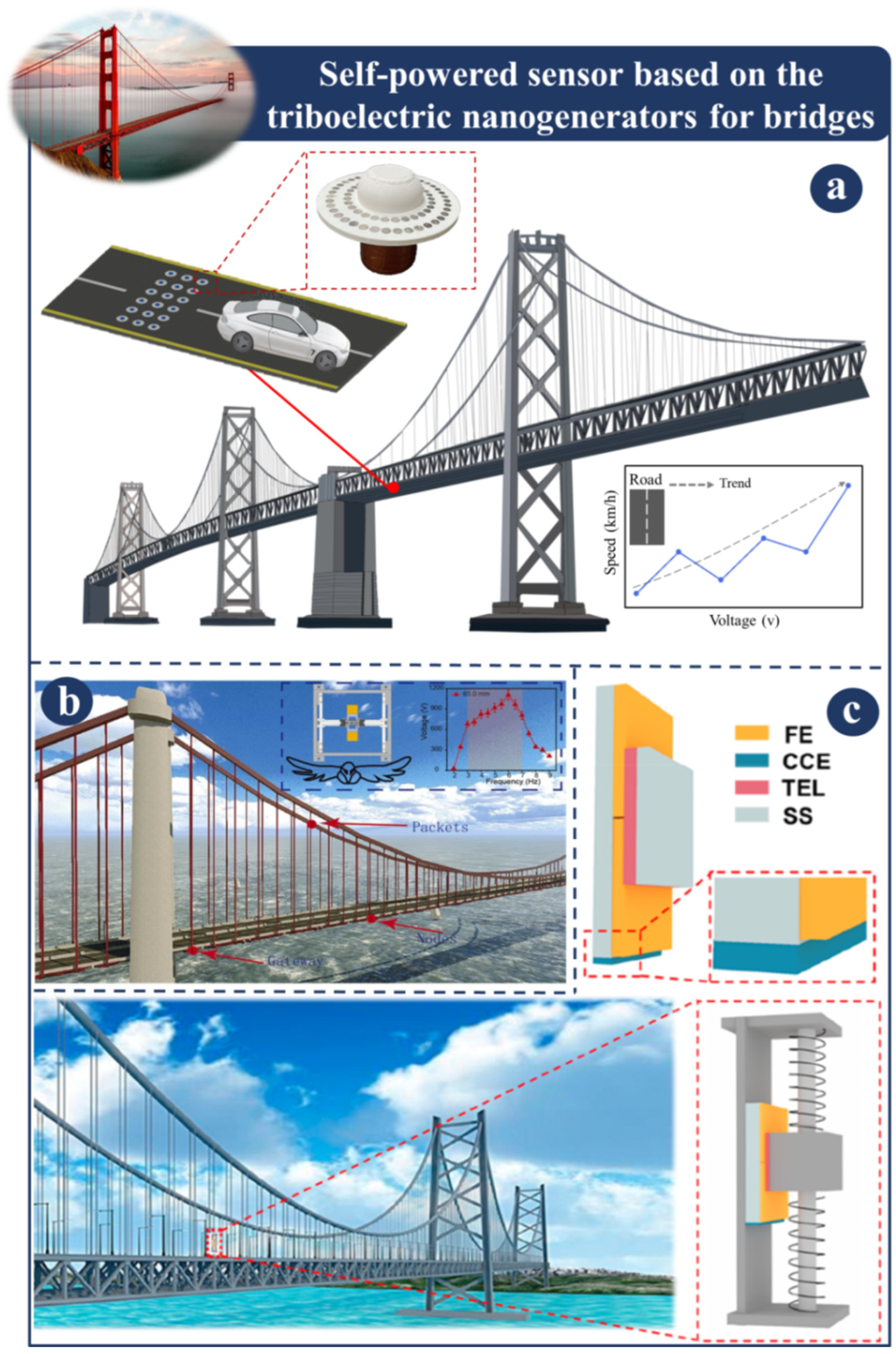
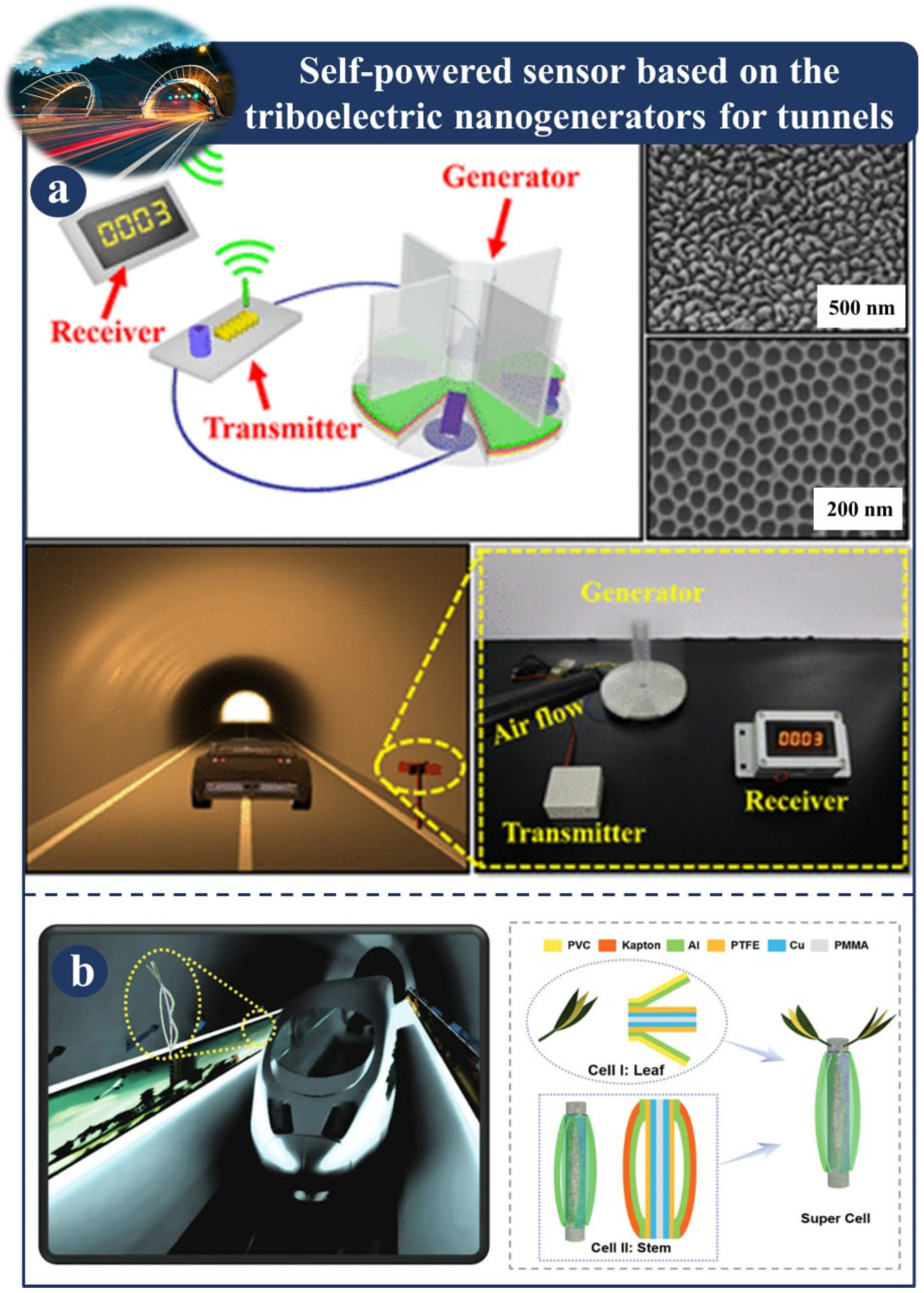
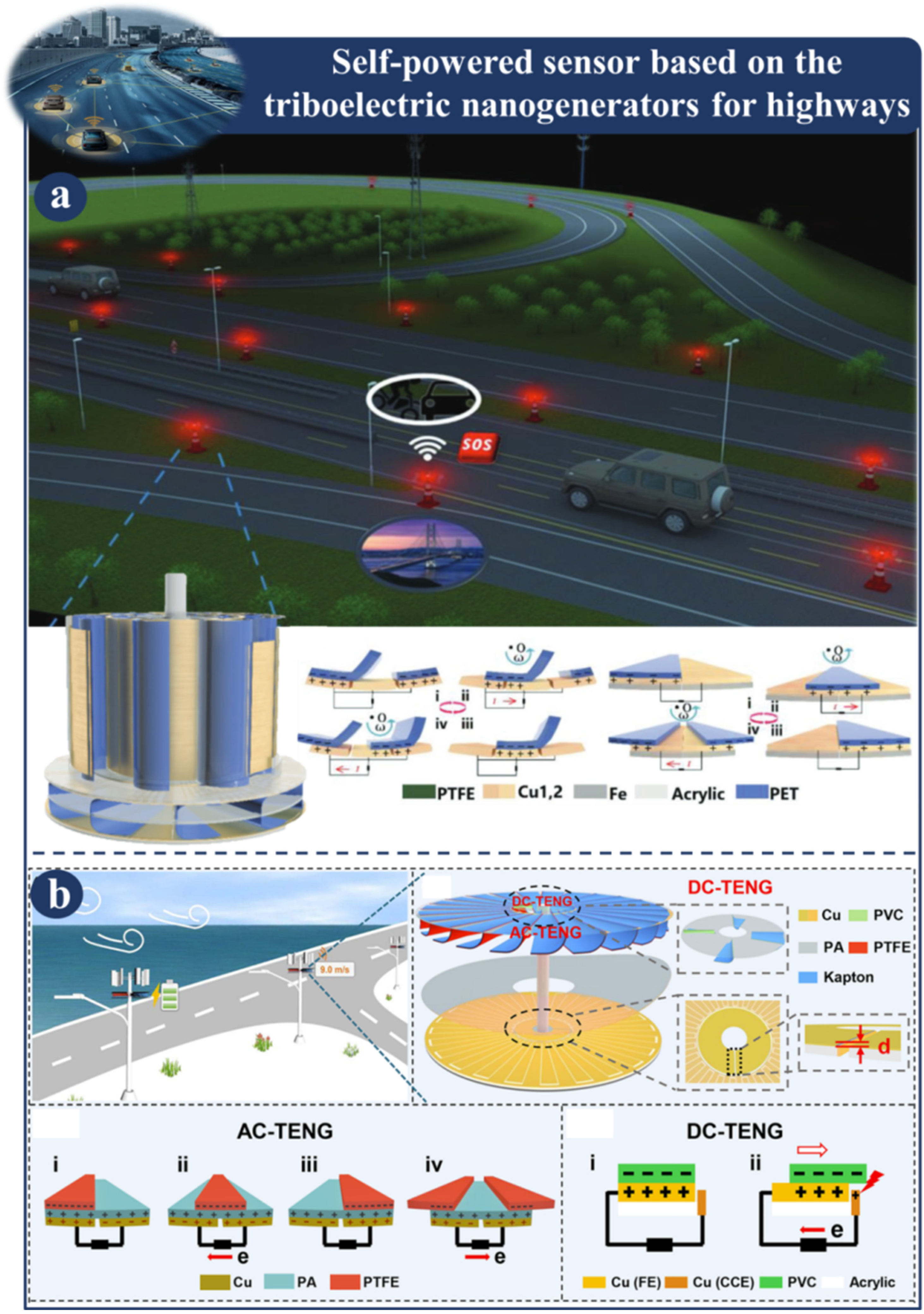
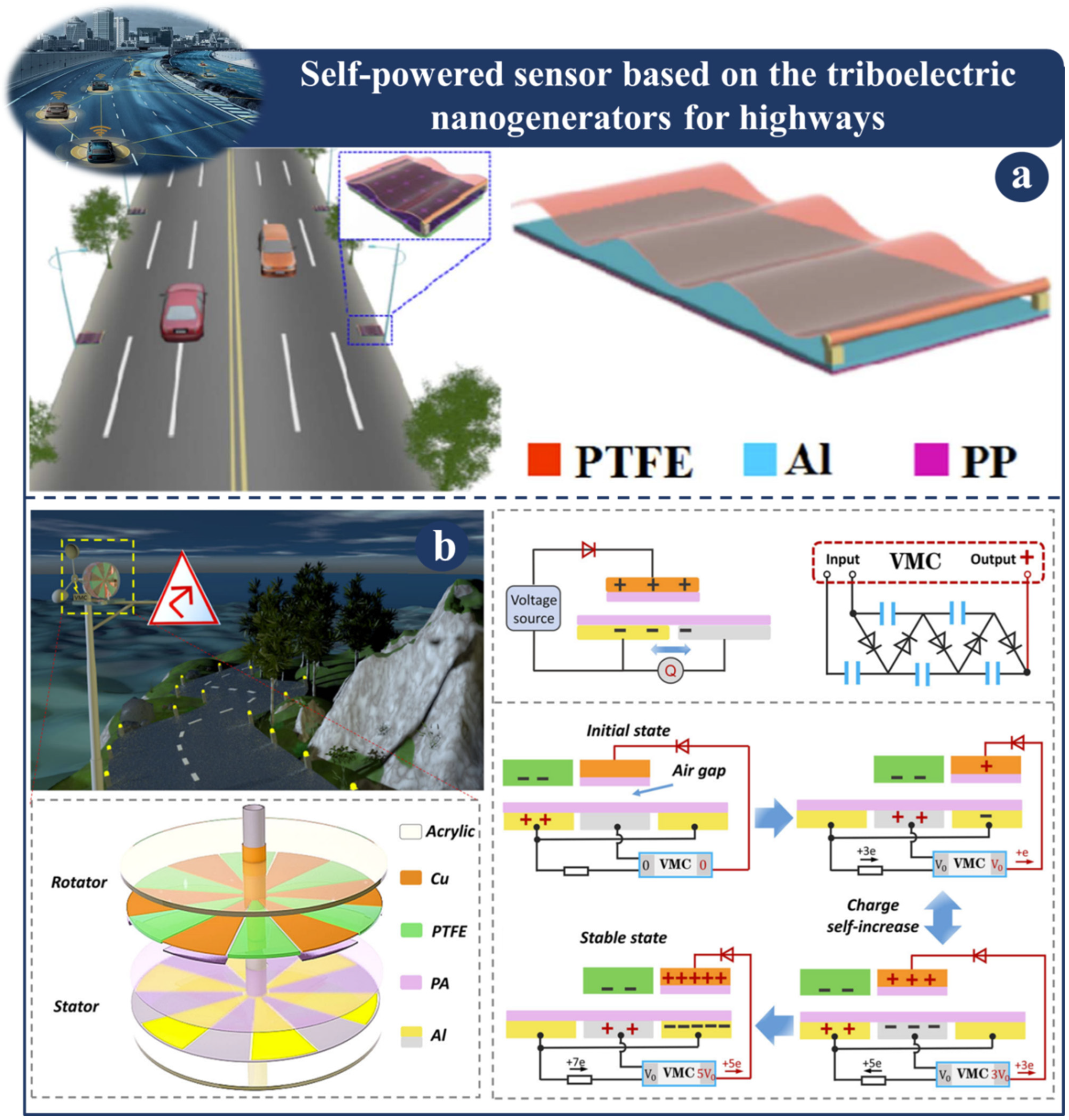
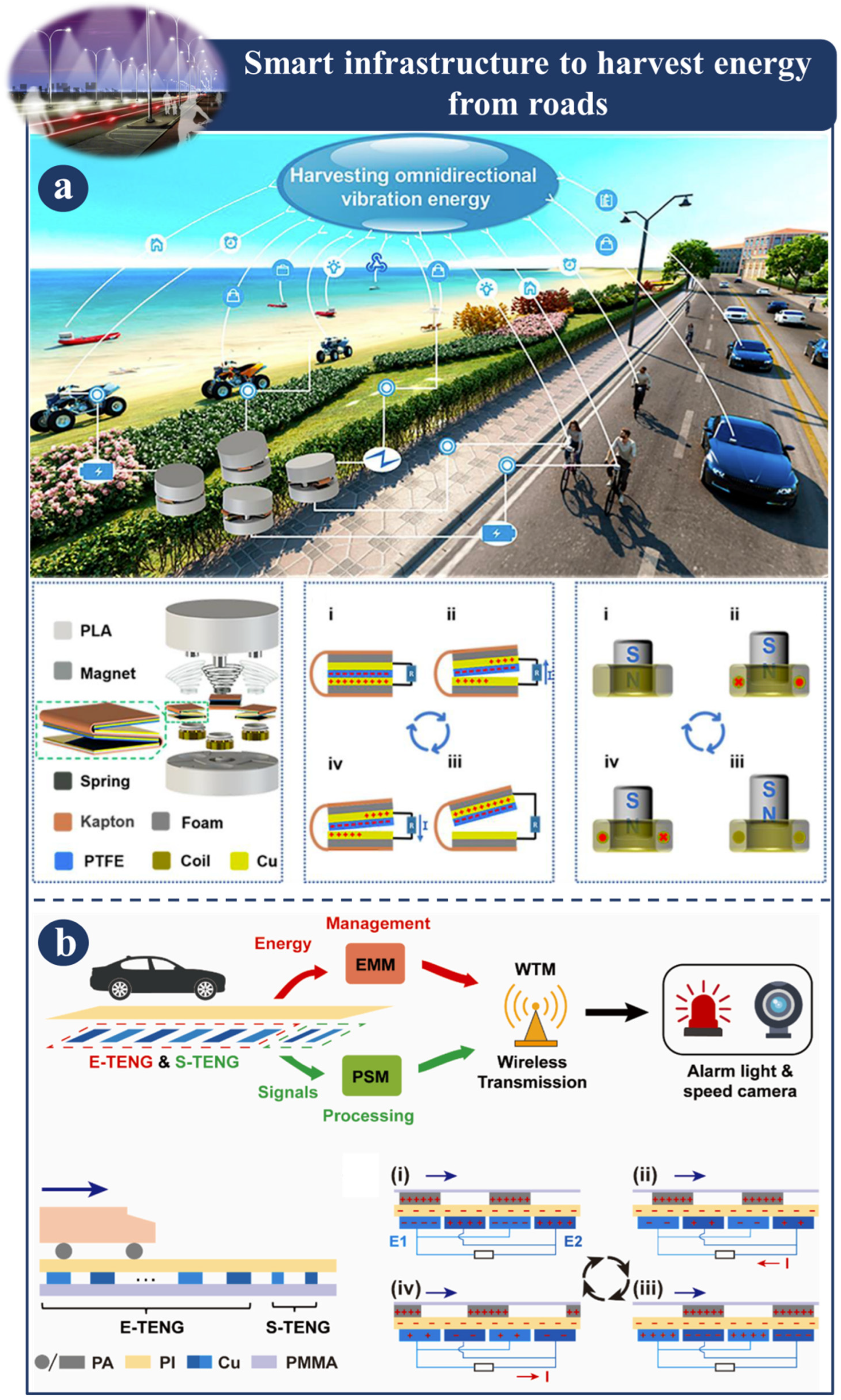
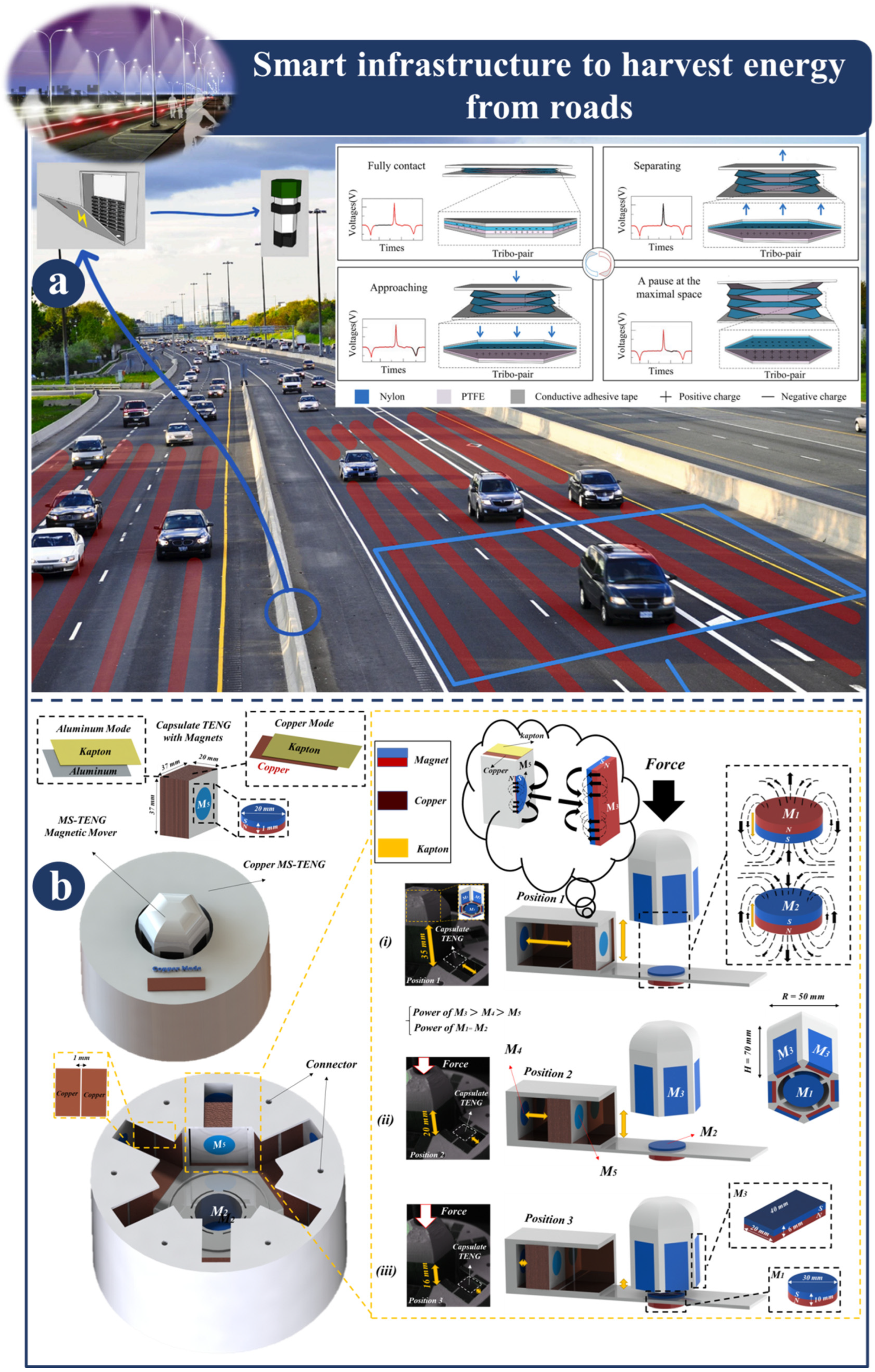

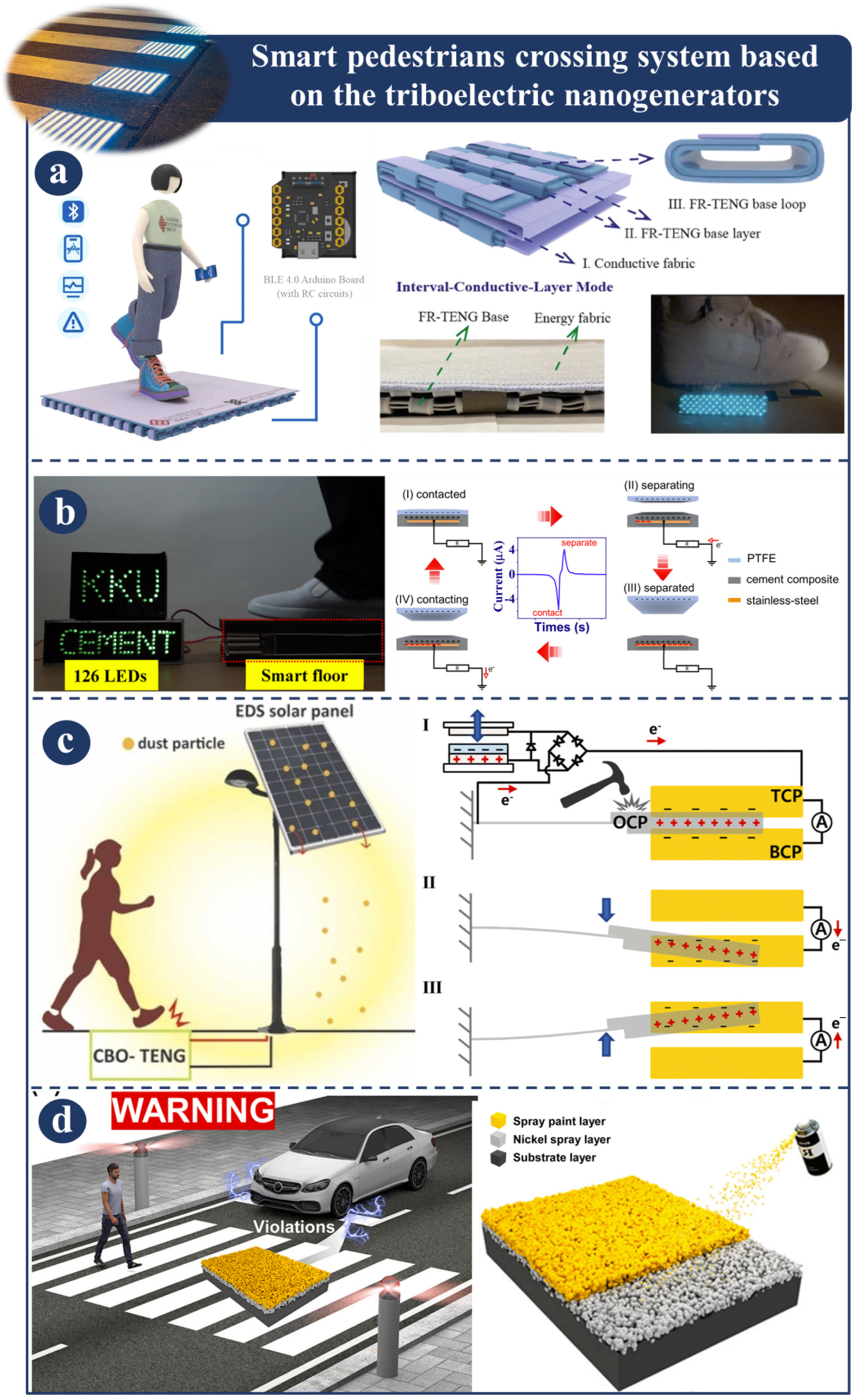


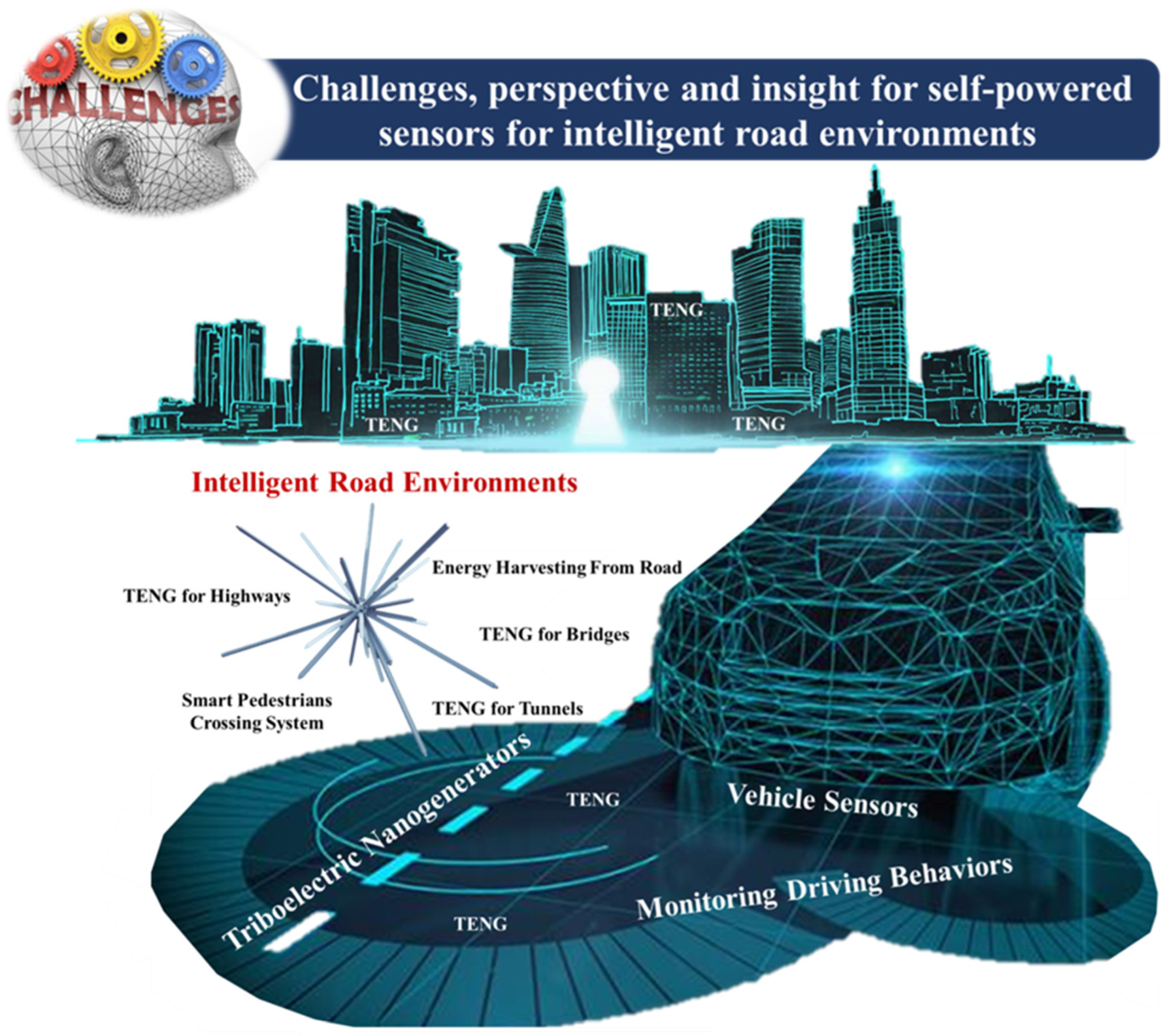
| Method | Description |
|---|---|
| Kinetic energy harvesting | This approach involves harnessing the vehicle’s kinetic energy during braking or deceleration using regenerative braking systems, which convert mechanical energy into electrical energy. Triboelectric nanogenerators can also capture energy from friction between two materials in contact, such as tires and the road surface. |
| Vibration energy harvesting | Vibrations generated by vehicle movement or engine operation can be converted into electrical energy. Piezoelectric nanogenerators utilize piezoelectric materials that produce an electric charge in response to mechanical stress, enabling the conversion of vehicle vibrations into usable power. |
| Solar energy harvesting | Vehicles can incorporate solar panels to capture sunlight and convert it into electrical energy. Solar powered vehicles or solar charging systems integrated into the vehicle’s body or roof can harness the sun’s energy for auxiliary systems or charging the vehicle’s battery. |
| Thermoelectric energy harvesting | This method utilizes the temperature difference between the vehicle’s engine and the surrounding environment. Thermoelectric materials, including those based on triboelectric or piezoelectric principles, can convert this temperature gradient into electrical energy. |
| Wind energy harvesting | Moving vehicles create airflow, which can be utilized through small wind turbines or wind capturing structures. These devices convert the kinetic energy of the moving air into electrical power, contributing to vehicle energy harvesting. |
| Electromagnetic induction | By utilizing magnetic fields, electromagnetic induction harvests energy from the vehicle’s mechanical movement or changing magnetic fields. This method can involve road-embedded coils or electromagnetic systems that interact with the vehicle’s components, converting mechanical energy into electrical power. |
| Triboelectric nanogenerators | Triboelectric nanogenerators convert mechanical energy from vehicle motion or vibrations into electricity through the triboelectric effect. This effect is based on the charge transfer between two materials with different electron affinities when they come into contact or separate. |
| Piezoelectric nanogenerators | Piezoelectric nanogenerators utilize materials that generate electric charge in response to mechanical strain or vibrations. When subjected to vehicle vibrations or deformations, these materials can produce electrical energy. |
| Structure | Year | Authors | Applications | Max Open- Circuit Voltage (V) | Max Short- Circuit Current | Surface Power Density/Power | TENG Mode |
|---|---|---|---|---|---|---|---|
| Self-powered sensors for bridges | 2022 | Jiao et al. [20] | Velocity sensing and damage detection | 5.1 V | - | 9 µW | FS |
| 2022 | Luo et al. [107] | Harvesting low-frequency vibrations | 1108 V | 12.17 μA | 1.25 mW | FS | |
| 2020 | Li et al. [108] | Vibration monitoring systems | 30 V | 200 nA | - | FS | |
| Self-powered sensors for tunnels | 2016 | Zhang et al. [109] | Traffic volume sensors | 3.5 V | 5 mA | 17.5 mW | LS |
| 2018 | Bian et al. [110] | Harvesting wind energy | 330 V | 59.6 µA | 3.6 mW | CS | |
| Self-powered sensors for highways | 2022 | Yang et al. [111] | Traffic monitoring and warning | 968.82 V | 14.103 µA | 22 W | FS |
| 2022 | He et al. [112] | Windspeed monitoring | 1140 V | 0.64 mA | 267.3 mW | FS/LS | |
| 2017 | Wang et al. [61] | Multifunctional sensing | 140 V | 1 μA | - | CS | |
| 2021 | Long et al. [113] | Energy harvesting | 150 V | 17.6 μA | 16.7 mW | FS | |
| Smart infrastructure to harvest energy from roads | 2022 | Cao et al. [114] | Vibration energy | 1.75 V | - | - | CS |
| 2022 | Cao et al. [44] | Intelligent transportation | 150 V | 1.3 μA | 42 mW | FS | |
| 2020 | Zhang et al. [115] | Energy harvesting | - | - | 20.25 µW | CS | |
| 2021 | Matin Nazar et al. [116] | Energy harvesting and active sensing | 4 V | - | - | FS | |
| Self-powered vehicle sensors for road intelligent systems | 2018 | Guo et al. [117] | Vehicle sensors | 140 V | 25 µA | 4.2 mW | FS |
| 2018 | Qian et al. [118] | Tire pressure monitoring system | 316 V | - | 22.3 mW | CS | |
| 2021 | Yang et al. [119] | Intelligent vehicle monitoring | 72 V | 76 µA | - | FS | |
| Smart pedestrians crossing system | 2022 | Jiang et al. [120] | Monitoring of human motions | 418.09 V | 65.85 µA | 199.14 µW·cm−2 | CS |
| 2022 | Kuntharin et al. [121] | Energy harvesting | - | - | 2.38 W/m2 | SE | |
| 2022 | Ma et al. [122] | Daily life self-cleaning solar panel | 1300 V | 16 µA | - | CS | |
| 2021 | Yun et al. [123] | Smart traffic system | 80 V | 7.2 µA | - | SE | |
| Self-powered sensors for monitoring driving behaviors | 2021 | Xu et al. [124] | Monitoring driver | 9 V | - | - | FS |
| 2019 | Feng et al. [106] | Monitoring driver | 6.98 V | 24.53 nA | - | CS | |
| 2020 | Xie et al. [125] | Energy harvesting/monitoring driver | 400 V | 15 µA | - | FS | |
| 2021 | Lu et al. [79] | Monitoring driver | 220 V | - | - | SE |
Disclaimer/Publisher’s Note: The statements, opinions and data contained in all publications are solely those of the individual author(s) and contributor(s) and not of MDPI and/or the editor(s). MDPI and/or the editor(s) disclaim responsibility for any injury to people or property resulting from any ideas, methods, instructions or products referred to in the content. |
© 2023 by the authors. Licensee MDPI, Basel, Switzerland. This article is an open access article distributed under the terms and conditions of the Creative Commons Attribution (CC BY) license (https://creativecommons.org/licenses/by/4.0/).
Share and Cite
Rayegani, A.; Matin Nazar, A.; Rashidi, M. Advancements in Triboelectric Nanogenerators (TENGs) for Intelligent Transportation Infrastructure: Enhancing Bridges, Highways, and Tunnels. Sensors 2023, 23, 6634. https://doi.org/10.3390/s23146634
Rayegani A, Matin Nazar A, Rashidi M. Advancements in Triboelectric Nanogenerators (TENGs) for Intelligent Transportation Infrastructure: Enhancing Bridges, Highways, and Tunnels. Sensors. 2023; 23(14):6634. https://doi.org/10.3390/s23146634
Chicago/Turabian StyleRayegani, Arash, Ali Matin Nazar, and Maria Rashidi. 2023. "Advancements in Triboelectric Nanogenerators (TENGs) for Intelligent Transportation Infrastructure: Enhancing Bridges, Highways, and Tunnels" Sensors 23, no. 14: 6634. https://doi.org/10.3390/s23146634
APA StyleRayegani, A., Matin Nazar, A., & Rashidi, M. (2023). Advancements in Triboelectric Nanogenerators (TENGs) for Intelligent Transportation Infrastructure: Enhancing Bridges, Highways, and Tunnels. Sensors, 23(14), 6634. https://doi.org/10.3390/s23146634








